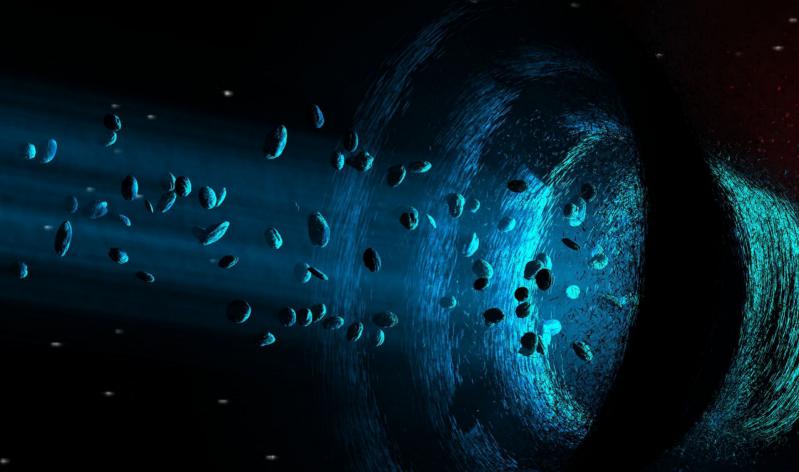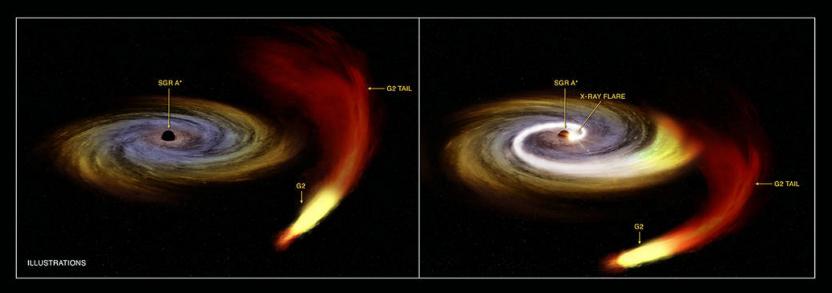Astronomy
 A recent close passage of a mysterious dusty object called G2, may have increased the feeding rate of a supermassive black hole which, weighs slightly more than 4 million times the mass of Sun at the center our galaxy.
A recent close passage of a mysterious dusty object called G2, may have increased the feeding rate of a supermassive black hole which, weighs slightly more than 4 million times the mass of Sun at the center our galaxy.
This information have come out after a new long-term monitoring under which three orbiting X-ray space telescopes have detected an increased rate of X-ray flares from the giant black hole 'Sagittarius A*' at the center of our Milky Way galaxy.
By combining information from long monitoring campaigns by NASA?s Chandra X-ray Observatory and ESA?s XMM-Newton, with observations by the Swift satellite, astronomers were able to carefully trace the activity of the Milky Way?s supermassive black hole over the last 15 years.
X-rays are produced by hot gas flowing toward the black hole and the new study reveals that Sagittarius A* [Sgr A* for short] has been producing one bright X-ray flare about every ten days. However, within the past year, there has been a ten-fold increase in the rate of bright flares from Sgr A*, at about one every day. This increase happened soon after the close approach to Sgr A* by the mysterious object called G2.
?For several years, we?ve been tracking the X-ray emission from Sgr A*. This includes also the close passage of this dusty object? said Gabriele Ponti of the Max Planck Institute for Extraterrestrial Physics in Germany. ?A year or so ago, we thought it had absolutely no effect on Sgr A*, but our new data raise the possibility that that might not be the case."

Originally, astronomers thought G2 was an extended cloud of gas and dust. However, after passing close to Sgr A* in late 2013, its appearance did not change much, apart from being slightly stretched by the gravity of the black hole. This led to new theories that G2 was not simply a gas cloud, but instead a star swathed in an extended dusty cocoon.
?There isn?t universal agreement on what G2 is,? said Mark Morris of the University of California at Los Angeles. ?However, the fact that Sgr A* became more active not long after G2 passed by suggests that the matter coming off of G2 might have caused an increase in the black hole?s feeding rate.?
While the timing of G2?s passage with the surge in X-rays from Sgr A* is intriguing astronomers see other black holes that seem to behave like Sgr A*. Therefore, it?s possible this increased chatter from Sgr A* may be a common trait among black holes and unrelated to G2. For example, the increased X-ray activity could be due to a change in the strength of winds from nearby massive stars that are feeding material to the black hole.
?It?s too soon to say for sure, but we will be keeping X-ray eyes on Sgr A* in the coming months,? said co-author Barbara De Marco, also of Max Planck. ?Hopefully, new observations will tell us whether G2 is responsible for the changed behavior or if the new flaring is just part of how the black hole behaves.?
You may also like:- Study reveals the link between black holes and galaxy merger.
The analysis included 150 Chandra and XMM-Newton observations pointed at the center of the Milky Way over the last 15 years, extending from September 1999 to November 2014. An increase in the rate and brightness of bright flares from Sgr A* occurred after mid-2014, several months after the closest approach of G2 to the huge black hole.
If the G2 explanation is correct, the spike in bright X-ray flares would be the first sign of excess material falling onto the black hole because of the cloud?s close passage. Some gas would likely have been stripped off the cloud, and captured by the gravity of Sgr A*. It then could have started interacting with hot material flowing towards the black hole, funneling more gas toward the black hole that could later be consumed by Sgr A*.
Scientists are now trying to learn whether this is a normal behavior that was unnoticed due to limited monitoring, or these flares are triggered by the recent close passage of the mysterious dusty object G2.
source:- nasa.gov
- Hubble Witnesses Flaring In Jet From Black Hole
A flare-up in a jet of matter blasting from a monster black hole is giving astronomers an incredible light show. The outburst is coming from a blob of matter, called HST-1, embedded in the jet, a powerful narrow beam of hot gas produced by a supermassive...
- A Supermassive Black Hole In A Dwarf Galaxy
A supermassive black hole exists in the center of our galaxy, with an incredible mass on the order of 4 million times that of the Sun. Our galaxy is not alone; most large galaxies also possess very large black holes as well. This leads to some interesting...
- Black Hole With Mass Of 140 Million Suns Discovered
Researchers have discovered a massive black hole at the centre of a distant galaxy which has the mass of 140 million Suns. The black hole is in the heart of galaxy NGC 1097, which is 47 million light-years away from Earth. According to...
- Nearest Black Hole(or Neutron Star)
According to NASA, astronomers, using Chandra X-ray observatory had almost found a youngest possible Black hole known to exist in our cosmic background, and they even said that it appears to be our nearest possible. The 30-year-old object provides a...
- Milky Way
Milky Way Facts It?s warped. The Milky Way is a disk about 120,000 light years across , with a central bulge that has a diameter...
Astronomy
Mysterious object G2 may have Increased the Feeding Rate of Milky Way's center Black hole.

This information have come out after a new long-term monitoring under which three orbiting X-ray space telescopes have detected an increased rate of X-ray flares from the giant black hole 'Sagittarius A*' at the center of our Milky Way galaxy.
By combining information from long monitoring campaigns by NASA?s Chandra X-ray Observatory and ESA?s XMM-Newton, with observations by the Swift satellite, astronomers were able to carefully trace the activity of the Milky Way?s supermassive black hole over the last 15 years.
X-rays are produced by hot gas flowing toward the black hole and the new study reveals that Sagittarius A* [Sgr A* for short] has been producing one bright X-ray flare about every ten days. However, within the past year, there has been a ten-fold increase in the rate of bright flares from Sgr A*, at about one every day. This increase happened soon after the close approach to Sgr A* by the mysterious object called G2.
?For several years, we?ve been tracking the X-ray emission from Sgr A*. This includes also the close passage of this dusty object? said Gabriele Ponti of the Max Planck Institute for Extraterrestrial Physics in Germany. ?A year or so ago, we thought it had absolutely no effect on Sgr A*, but our new data raise the possibility that that might not be the case."

Originally, astronomers thought G2 was an extended cloud of gas and dust. However, after passing close to Sgr A* in late 2013, its appearance did not change much, apart from being slightly stretched by the gravity of the black hole. This led to new theories that G2 was not simply a gas cloud, but instead a star swathed in an extended dusty cocoon.
?There isn?t universal agreement on what G2 is,? said Mark Morris of the University of California at Los Angeles. ?However, the fact that Sgr A* became more active not long after G2 passed by suggests that the matter coming off of G2 might have caused an increase in the black hole?s feeding rate.?
While the timing of G2?s passage with the surge in X-rays from Sgr A* is intriguing astronomers see other black holes that seem to behave like Sgr A*. Therefore, it?s possible this increased chatter from Sgr A* may be a common trait among black holes and unrelated to G2. For example, the increased X-ray activity could be due to a change in the strength of winds from nearby massive stars that are feeding material to the black hole.
?It?s too soon to say for sure, but we will be keeping X-ray eyes on Sgr A* in the coming months,? said co-author Barbara De Marco, also of Max Planck. ?Hopefully, new observations will tell us whether G2 is responsible for the changed behavior or if the new flaring is just part of how the black hole behaves.?
You may also like:- Study reveals the link between black holes and galaxy merger.
The analysis included 150 Chandra and XMM-Newton observations pointed at the center of the Milky Way over the last 15 years, extending from September 1999 to November 2014. An increase in the rate and brightness of bright flares from Sgr A* occurred after mid-2014, several months after the closest approach of G2 to the huge black hole.
If the G2 explanation is correct, the spike in bright X-ray flares would be the first sign of excess material falling onto the black hole because of the cloud?s close passage. Some gas would likely have been stripped off the cloud, and captured by the gravity of Sgr A*. It then could have started interacting with hot material flowing towards the black hole, funneling more gas toward the black hole that could later be consumed by Sgr A*.
Scientists are now trying to learn whether this is a normal behavior that was unnoticed due to limited monitoring, or these flares are triggered by the recent close passage of the mysterious dusty object G2.
source:- nasa.gov
- Hubble Witnesses Flaring In Jet From Black Hole
A flare-up in a jet of matter blasting from a monster black hole is giving astronomers an incredible light show. The outburst is coming from a blob of matter, called HST-1, embedded in the jet, a powerful narrow beam of hot gas produced by a supermassive...
- A Supermassive Black Hole In A Dwarf Galaxy
A supermassive black hole exists in the center of our galaxy, with an incredible mass on the order of 4 million times that of the Sun. Our galaxy is not alone; most large galaxies also possess very large black holes as well. This leads to some interesting...
- Black Hole With Mass Of 140 Million Suns Discovered
Researchers have discovered a massive black hole at the centre of a distant galaxy which has the mass of 140 million Suns. The black hole is in the heart of galaxy NGC 1097, which is 47 million light-years away from Earth. According to...
- Nearest Black Hole(or Neutron Star)
According to NASA, astronomers, using Chandra X-ray observatory had almost found a youngest possible Black hole known to exist in our cosmic background, and they even said that it appears to be our nearest possible. The 30-year-old object provides a...
- Milky Way
Milky Way Facts It?s warped. The Milky Way is a disk about 120,000 light years across , with a central bulge that has a diameter...
